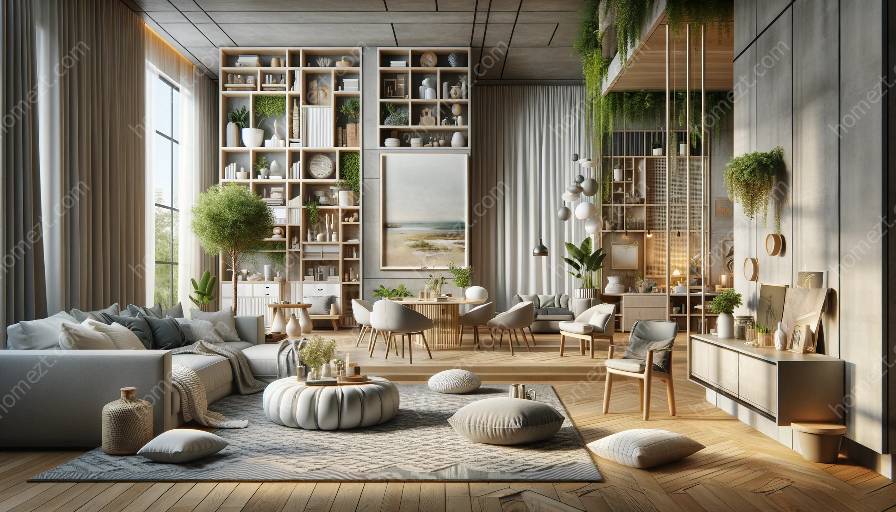Global environmental issues have become a major concern in recent years, with a growing focus on sustainability, eco-friendly practices, and the preservation of resources. These issues have also started to influence various industries, including interior design and styling. When it comes to space planning and optimization in interior design, the impact of global environmental issues is significant, as it has led to a shift in the way spaces are designed, utilized, and optimized.
The Influence of Global Environmental Issues on Space Planning and Optimization
Space planning in interior design involves the organization and allocation of interior space to accommodate various activities and functions while optimizing the available resources. Optimization, on the other hand, focuses on maximizing the potential of a space in terms of functionality, aesthetics, and efficiency.
Global environmental issues, such as climate change, resource depletion, and pollution, have led interior designers to reconsider their approach to space planning and optimization. The need for sustainable and environmentally-friendly design solutions has become a driving force in the industry, prompting designers to integrate eco-conscious practices into their projects.
Sustainable Materials and Resources
One of the key ways in which global environmental issues influence space planning and optimization in interior design is through the use of sustainable materials and resources. Designers are now incorporating eco-friendly materials, such as reclaimed wood, bamboo, and recycled metals, into their designs to reduce the environmental impact of their projects. By making conscious choices about the materials they use, designers can contribute to the conservation of natural resources and promote sustainable practices.
Energy Efficiency and Environmental Impact
Energy efficiency is another area where global environmental issues play a significant role in space planning and optimization. Designers are increasingly considering the environmental impact of the energy consumption within interior spaces. This has led to the integration of energy-efficient lighting, heating, and cooling systems, as well as the use of natural lighting and ventilation to reduce reliance on artificial energy sources.
Waste Reduction and Recycling
Global environmental issues have also influenced interior designers to prioritize waste reduction and recycling in their space planning and optimization strategies. Designers are implementing strategies to minimize construction waste and promote the recycling of materials during renovation and remodeling projects. By incorporating recycling initiatives into their designs, designers can contribute to the reduction of landfill waste and the conservation of valuable resources.
Integration of Sustainable Practices
The integration of sustainable practices has become a fundamental aspect of space planning and optimization in interior design. Designers are now incorporating green building principles, such as LEED certification and sustainable design standards, into their projects to meet the growing demand for environmentally-friendly spaces.
Additionally, the concept of biophilic design, which aims to connect occupants with nature through the use of natural elements and materials, has gained traction in response to global environmental issues. This approach not only enhances the aesthetic appeal of interior spaces but also fosters a connection to the natural environment, supporting the well-being of occupants.
Human Health and Well-being
Global environmental issues have highlighted the importance of creating interior spaces that promote human health and well-being. As a result, space planning and optimization now prioritize the incorporation of indoor air quality management, sustainable and non-toxic materials, and ergonomic design elements to enhance the overall comfort and health of occupants.
Adaptability and Flexibility
In response to the dynamic nature of global environmental issues, interior designers are exploring adaptable and flexible design solutions that can accommodate changing needs and environmental conditions. Spaces are being designed with the ability to be reconfigured, repurposed, and optimized to adapt to evolving environmental challenges, such as extreme weather events and population shifts.
The Role of Technology
The advancement of technology has also played a crucial role in addressing global environmental issues within the context of space planning and optimization in interior design. Designers are leveraging innovative technologies, such as Building Information Modeling (BIM) and energy simulation software, to analyze and optimize the environmental performance of interior spaces. These tools enable designers to assess the environmental impact of their designs and make informed decisions to minimize resource consumption and maximize efficiency.
Conclusion
In conclusion, global environmental issues exert a profound influence on space planning and optimization in interior design. The integration of sustainable practices, the prioritization of energy efficiency, the promotion of waste reduction, and the consideration of human health and well-being are just a few examples of how environmental concerns have reshaped the approach to interior design. By embracing eco-friendly principles and adopting strategies that align with sustainable development goals, interior designers can contribute to the creation of spaces that not only respond to environmental challenges but also foster a healthier and more resilient built environment.


























